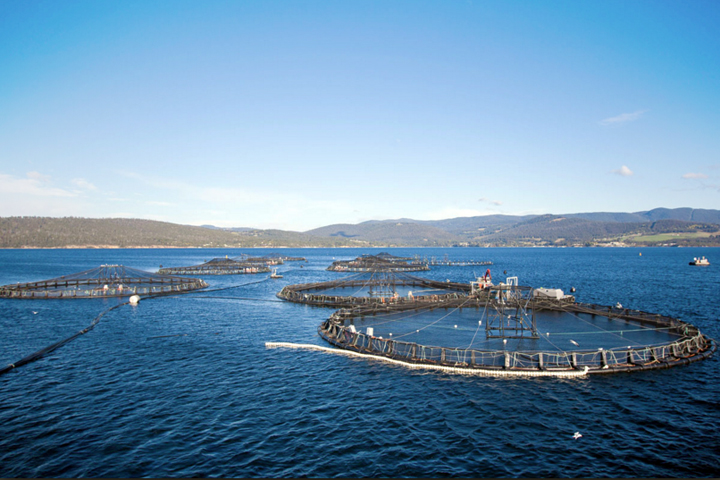If Tasmania wants to lead the world in fish farming it will have to deploy public resources for environmental monitoring.

Humans need food, but producing it is hard work. A long time ago they worked out that most people could avoid such work if they corralled four-legged animals and tilled the soil.
This is farming, which over thousands of years has enabled cities to grow, along with governments, creative arts, science, sport and everything else that adds up to civilisation. But it came at a price.
As hunters and gatherers we moved through the landscape; as farmers we transformed it, draining marshes, clearing forests and making barriers to free movement in the form of fences.
We see clearly now that farming the land has its limits The swamps and forests we saw as obstacles turn out to have their own value as biologically diverse, productive natural habitats, while trees contribute massively to a stable global climate.
Given those limits and the eternal and growing demand for food, where should we turn? Where else but the sea? That story is playing out around Tasmania as various aquaculture interests compete for a share of a rapidly growing market in farmed finfish, mostly Atlantic salmon.
This has not gone unnoticed by the Tasmanian government, whose recently-released Sustainable industry growth plan for the salmon industry described Tasmanian farmed salmon as “not only the largest primary industry in the State… but also the nation’s largest seafood product by volume.”
A written introduction to the plan by primary industries minister Jeremy Rockliff described the government as “a strong supporter of the salmon industry”, pointing out its important contribution to jobs in regional Tasmania.
Tasmania’s biggest producer, Tassal, says the industry employs over 2000 people directly and another 10,000 indirectly. An Australia Institute study commissioned by the abalone industry puts the total at around 1000 jobs, less than the combined total for fishing and shellfish aquaculture.
Tassal’s website points out that its active farming leases amount to just 0.010561 per cent of the area of Tasmania and its territorial waters, which is true as far as it goes. Except that not all bits of land and sea are equal, especially when it comes to living things.
Shellfish like oysters and abalone feed on phytoplankton, which need sunlight to survive. Nearly all that is gone below about 30 metres, so shallow coastal waters are especially important for these wild sea-floor species. There, they have to coexist with fish farms.
It takes a lot of food to grow penned salmon. Much of that, with salmon faeces, falls into water below and to the sea floor. In some places, notably Macquarie Harbour, the waste has been found to cause a marked decline in dissolved oxygen in bottom water, affecting all sea-floor species.
Nearly all Tasmanian fish pens occupy sheltered inshore waterways, with a few in the more open waters of Storm Bay. No location could accurately be described as oceanic or deep-water.
If Tassal, Huon Aquaculture and Petuna are the farmers of the sea, professional and recreational fishers are its hunters and gatherers. Among these are abalone divers, part of an established, lucrative Tasmanian industry with a colourful past which it is now trying to put behind it.
Besides its earning capacity, the abalone industry has one other invaluable attribute. Abalone fishers secure their catch through diving, which means they have more personal knowledge of the undersea environment than any other active industry player.
According to the Tasmanian Abalone Council, the state’s $100 million a year wild abalone export industry, the world’s largest, is under threat from finfish farmers who don’t understand and cannot control the complexities of the natural environment into which they venture.
In its submission on the industry plan, the TAC identified the key impacts on the sea floor of open-cage salmon farming as sustained loads of nutrients and sediments, coming mainly from artificial feed and excreta but also including chemicals used in maintaining the pens.
It recommended an environmental buffer zone separating salmon farms from inshore reef systems to enable pollutants from pens to be diluted and dispersed by natural water movement, and requested a formal role in developing future finfish aquaculture policy.
The international standard for dealing with potential environmental impact is the precautionary principle, requiring transparent decision-making with public input and a clear demonstration, before any proposed activity begins, that it will not damage its natural surroundings.
Instead, the government has agreed with aquaculture companies that “adaptive management” is the way to go, whereby industry players make decisions based on their own monitoring and learning, with the only oversight being from government officers whose positions are funded by the industry.
This is a huge call. Contrary to world’s best practice, and rejecting advice from fishers able to see what is happening on the sea floor, the government has effectively put primary regulatory power into the hands of the finfish farmers themselves.
A genuinely sustainable, well regulated finfish farming industry with widespread public support ought to be eminently feasible. This could include more onshore operations that recycle water and recover waste as fertiliser.
But the best prospects seem to be in moving out of contested coastal waters to deeper, more dynamic waters able to disperse sediments. Huge, self-navigating submersible pens able to sink below damaging waves are already being trialled in North American and European waters.
In a world increasingly hungry for protein, Tasmania’s aquaculture industry can be a global leader, but that will require unimpeachable environmental credentials and informed, transparent regulation that is completely independent of industry, in both funding and operations.
That is not happening. The government, conflating straight-out political opposition with genuine public concern about environmental consequences, seems intent on casting its lot with the farmers. It needs to correct that bias, and the sooner the better.
